Letting users choose a payment method on WordPress forms can make the checkout experience much smoother. It gives people the freedom to pay using the method they’re most comfortable with, which can help build customer trust.
Many of our partner brands offer multiple payment methods on forms, and they have shared how this had a positive impact on their sales.
That’s why we tested some popular WordPress form tools that offer payment options. Through our research, we found that WP Simple Pay and WPForms make giving customers this option super easy. And if you’re using WooCommerce, you can handle this right from your dashboard.
In this article, we’ll show you how to allow users to choose a payment method on WordPress forms.
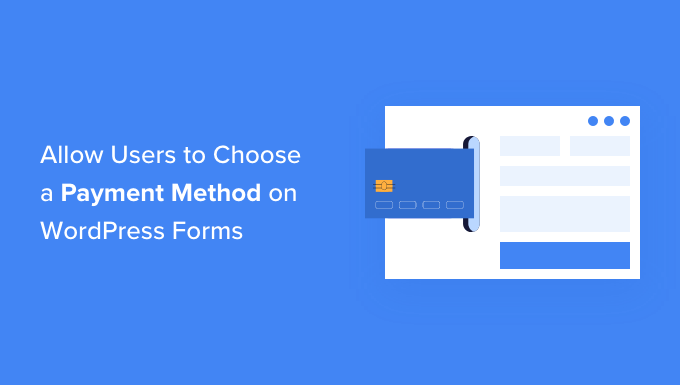
Why Offer Multiple Payment Methods in WordPress?
PayPal and credit cards are two popular ways to pay for online purchases. Each has its pros and cons, and your visitors are likely already to prefer one or the other.
So, if you’re selling products or services on your WordPress website or asking for donations, then it is important to allow your visitors to use their preferred payment method.
Now, you may already have a complete online store with a shopping cart.
But if you don’t have an online store, the good news is you don’t need to set one up to accept online payments. All you need is a simple online order form with payment options.
Especially if you’re selling a single product, accepting payments for services, or raising money for a cause or charity, the solution is definitely the better idea.
Before you can accept payments on your website, you’ll need to enable HTTPS/SSL so that you can accept payments securely. For more details, you can follow our guide on how to get a free SSL certificate for your WordPress site.
In this guide, we’re going to show you how to offer multiple payment options on your website. We’ll cover three methods so you can choose the one that best suits your needs.
Method 1 is the simplest and doesn’t require a full shopping cart. You should use Method 2 if you have a WooCommerce store. Method 3 is best if you don’t have an online store and want to use PayPal or create more flexible forms.
Feel free to use the quick link below to jump to your preferred method:
Ready? Let’s get started.
Method 1: Offering Multiple Payment Methods Using WP Simple Pay
WP Simple Pay is an easy way to offer multiple payment methods on your site. It’s a leading WordPress payment plugin that lets you receive payments without setting up a full-featured eCommerce store or membership site.
For more information, you can check out our WP Simple Pay review.
It uses Stripe, a popular payment gateway, to accept payments from credit cards, Apple Pay, Google Pay, ACH bank debit, SEPA direct debit, Alipay, Giropay, iDEAL, and more.
Now, the first thing you need to do is install and activate the WP Simple Pay plugin. For more details, please see our step-by-step guide on how to install a WordPress plugin.
While there is a free version of the plugin, you need the Pro plugin to create on-site payment forms, accept Apple Pay, and more.
Upon activation, the WP Simple Pay setup wizard will start automatically. You simply need to click the ‘Let’s Get Started’ button to continue.
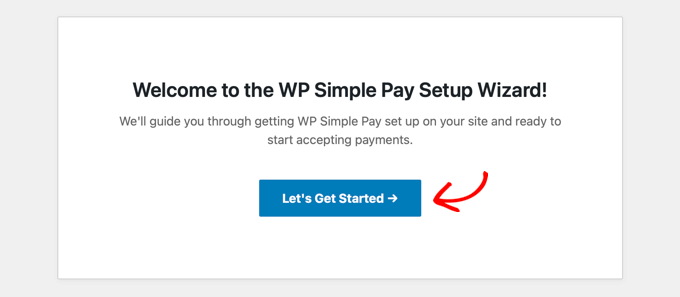
First, you’ll be asked to enter your license key. You can find this information in your account on the WP Simple Pay website.
After that, you need to click the ‘Activate and Continue’ button to move on.
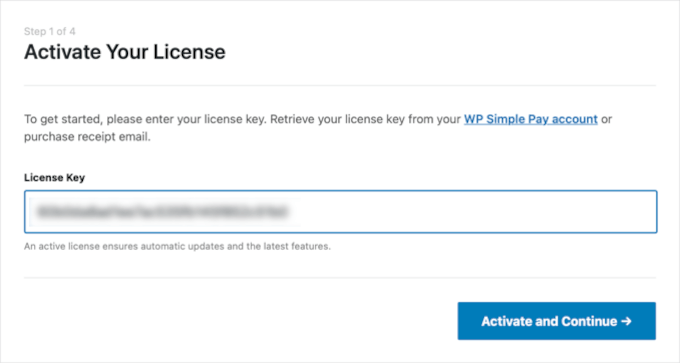
Next, you’ll need to connect WP Simple Pay to Stripe.
Start by clicking the ‘Connect with Stripe’ button. From there, you can log in to your Stripe account or create a new one. Anyone with a legitimate business can create a Stripe account and accept payments online.
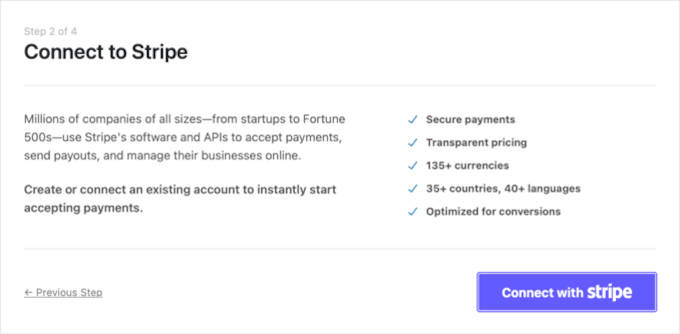
As we mentioned earlier, Stripe will require your site to be using SSL/HTTPS encryption. If you don’t already have an SSL certificate for your website, then please see our step-by-step guide on how to add SSL in WordPress.
Once you’ve connected to Stripe, you’ll be asked to configure your WP Simple Pay emails.
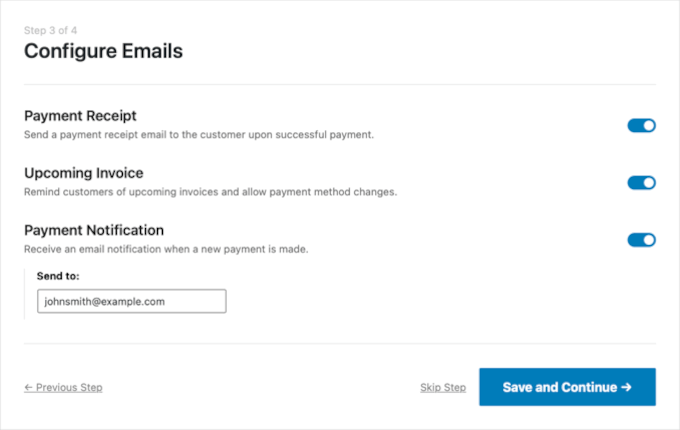
The options for payment and invoice emails to your customers have already been enabled for you. So has the option for sending payment notification emails.
This means that you just need to enter the email address where the notifications should be sent.
Once you’ve done that, you need to click the ‘Save and Continue’ button. This completes your setup of WP Simple Pay.
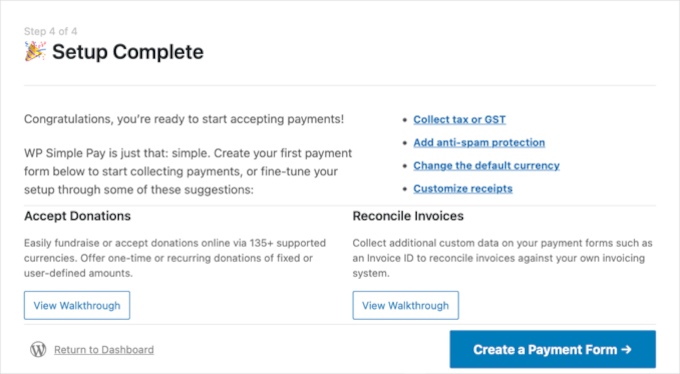
Before we move on, there’s one more setting you may need to configure. Some payment options work only for specific currencies, so if you are not using USD, you will need to change the default currency.
To do this, let’s visit WP Simple Pay » Settings.
From the ‘General’ tab, you’ll want to open the ‘Currency’ subtab. Then, you can select your currency from the drop-down menu.

Creating a Payment Form in WordPress
Now it’s time to create your payment form. WP Simple Pay offers plenty of ways to customize the form, but if you need more complete control over the way your form looks, then check out WPForms in Method 3.
If you didn’t need to change your currency and can still see the last page of the setup wizard, simply click the ‘Create a Payment Form’ button. Otherwise, you should navigate to the WP Simple Pay » Add New page.
In this area, you’ll see a list of payment form templates. You could start with a generic template such as ‘Payment Form’ and then add payment methods.
Alternatively, you can look for a more specific template, such as ‘Afterpay / Clearpay’ or ‘Apple Pay / Google Pay‘.
For this tutorial, we’ll choose the ‘Payment Form’ template. Now, simply hover over the template you wish to use and click the ‘Use Template’ button when it appears.
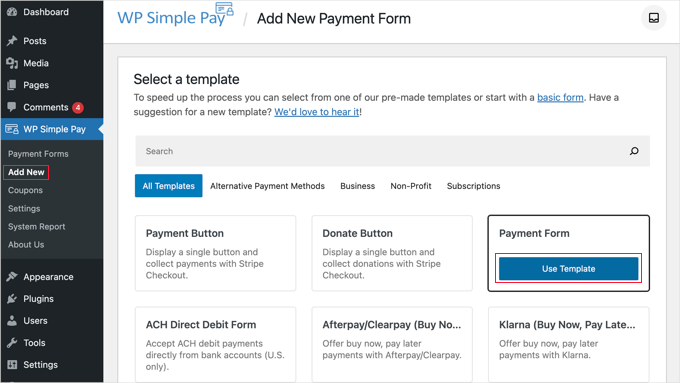
This will take you to the payment form editor.
You should start by giving the payment form a name and description. Then, under Form Type, you can select the ‘Stripe Checkout’ option.
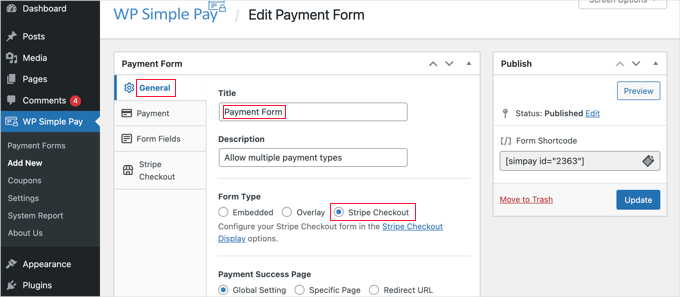
Next, you need to click on the ‘Payment’ tab. Here you can set the payment mode to either live or testing. Test mode will let you make payments that are not actually charged, so you can make sure your form is working properly and emails are being sent.
Don’t forget to change this to ‘Live’ when you’ve finished testing and are ready to start receiving payments from your customers.
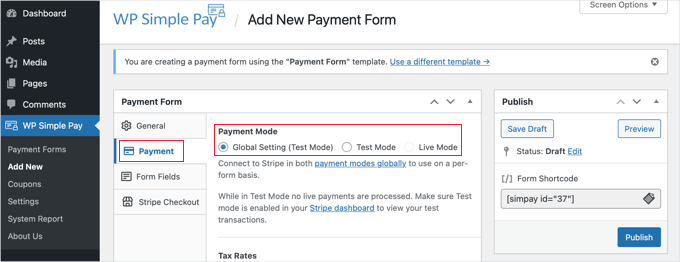
You can also add the products or services that you offer, along with their prices and whether they are a one-time payment or a subscription.
Simply click the ‘Add Price’ button until you have added as many prices as you need. Then, for each one, you will need to add a label and price. You can also select other options, such as if the price is a subscription, or the user can determine the price, as in a donation.
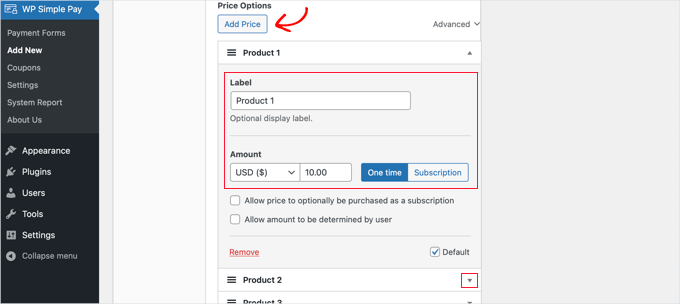
You can show or hide a price by clicking the small arrow on the right.
Next, we’ll move on to the ‘Form Fields’ tab. The essential fields have already been added to the form, and you can add more if necessary.
Using the ‘Form Fields’ drop-down, you can choose additional fields and add them by clicking the ‘Add Field’ button. Options include name, phone number, address, and much more.
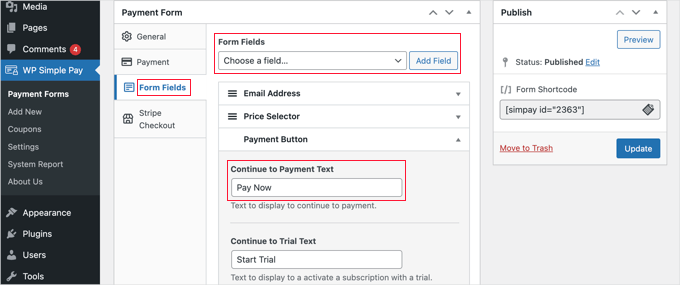
The default text on the button is ‘Pay with Card.’ Since you’ll be accepting multiple payment types, you can change the text to something more generic, such as simply ‘Pay Now.’ Then, your customers won’t assume that credit cards are the only payment option.
Finally, you should click the ‘Stripe Checkout’ tab and select the payment methods you wish to offer. For this tutorial, we’ll just leave the default settings.

Additional payment methods, such as Apple Pay, will be automatically offered on compatible devices. To learn more, see our guide on how to accept Apple Pay in WordPress.
Klarna and Afterpay are ‘buy now, pay later’ services and offer customers flexibility as they can purchase goods and pay in installments over a specified time period. For more information, see our guide on how to add ‘buy now pay later’ payment plans to WordPress.
When you are happy with your payment form, click the ‘Publish’ button to store your settings and push the form live.
The final step is to add the form to a post or page on your website.
Adding the Payment Form to Your Website
WP Simple Pay makes it super easy to add forms anywhere on your website.
Simply create a new post or page or edit an existing one. Then, click on the plus (+) sign at the top and add a WP Simple Pay block in the WordPress block editor.
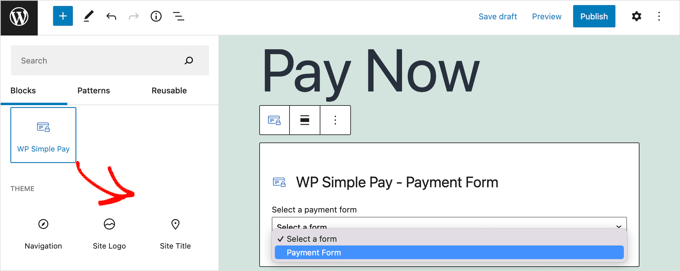
After that, select your order form from the dropdown menu in the WP Simple Pay block.
Once you’re finished, you can update or publish the post or page and then click on the preview button to see your form in action.
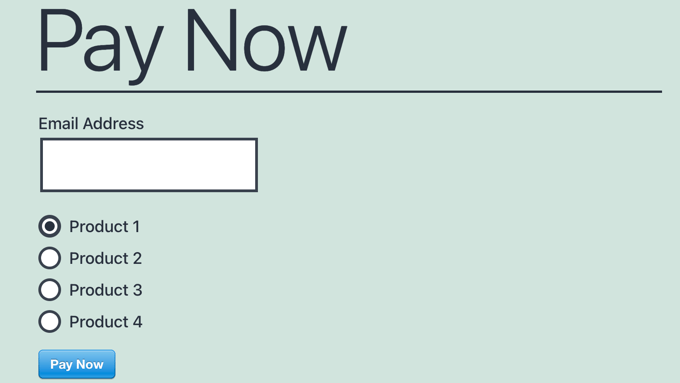
When your users click the ‘Pay Now’ button, the Stripe checkout form will be displayed. This will offer all of the payment options you checked earlier.
On supported devices and browsers, additional payment options such as Apple Pay will also be offered automatically.
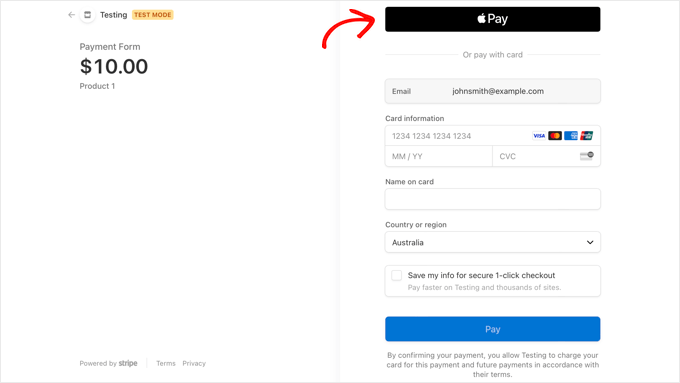
One additional payment method you can offer your customers using WP Simple Pay is recurring payments. For more information, see our guide on how to accept recurring payments in WordPress.
Method 2: Offering Multiple Payment Methods in WooCommerce
If you are running an online store using WooCommerce, then you can easily offer additional payment methods by using PayPal and the Stripe payment gateway.
WooCommerce is a free WordPress plugin trusted by over 3.9 million eCommerce websites. It’s packed with all the tools you need to turn your WordPress site into an online store and start selling your products. Get more information about the tool in our WooCommerce review.
For this tutorial, we’ll assume that you already have WooCommerce installed. If you need help setting it up, then see our step by step guide on WooCommerce.
Adding PayPal to Your WooCommerce Store
You may have already set up PayPal when following the WooCommerce setup wizard in that guide. If you have, then you can move on to the next section and set up Stripe.
If not, you need to head over to WooCommerce » Settings and then click the ‘Payments’ tab at the top of the screen.
After that, scroll down the page until you find PayPal and click the ‘Get started’ button.

You need to start by typing your PayPal email address and then selecting your country from the dropdown menu.
After entering these details, you can click the ‘Next’ button to continue.
If you already have a PayPal account using that email address, then you’ll be asked to provide your password and log in. Otherwise, you’ll first be asked to provide your personal details and create a new account.
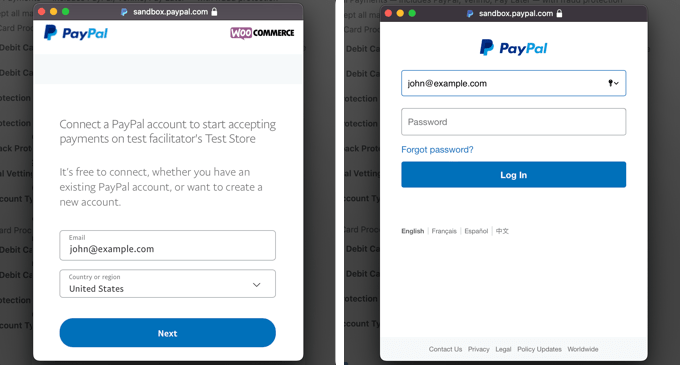
Finally, you should click the ‘Agree and Consent’ button to connect your PayPal account to the online store.
Once you’ve done that, you’ll need to confirm your email address by going to your inbox and following the instructions in the email you were sent. You can then dismiss the popup window by scrolling to the bottom and clicking the button.

You should find yourself back on the WooCommerce Payments settings page. Here, you will need to check the box to enable the PayPal payment gateway on your online store.
Then, carefully scroll down the page and make sure all the settings are correct. When you’re happy, you can click the ‘Save changes’ button at the bottom of the page.
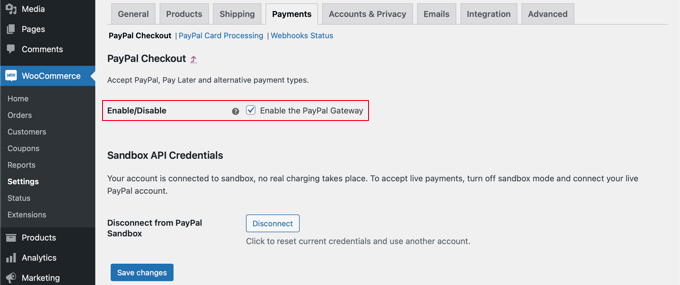
When checking out, your customers can now pay using PayPal as a payment option.
Adding Stripe to Your WooCommerce Store
To get started, the first thing you need to do is install and activate WooCommerce Stripe Payment Gateway. For more details, see our step-by-step guide on how to install a WordPress plugin.
Some payment options are only available for certain currencies. If you are using a currency other than USD, then you should navigate to WooCommerce » Settings and make sure you are on the ‘General’ tab.
Here you can choose the currency for your online store. Don’t forget to click the ‘Save’ button to store the settings.
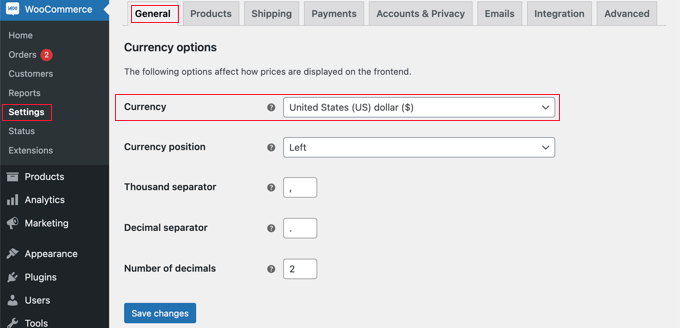
After that, you can click the ‘Payments’ tab.
In this tab, you’ll want to scroll down until you find ‘Stripe’ in the ‘Method’ column. Notice that there are multiple Stripe payment methods.
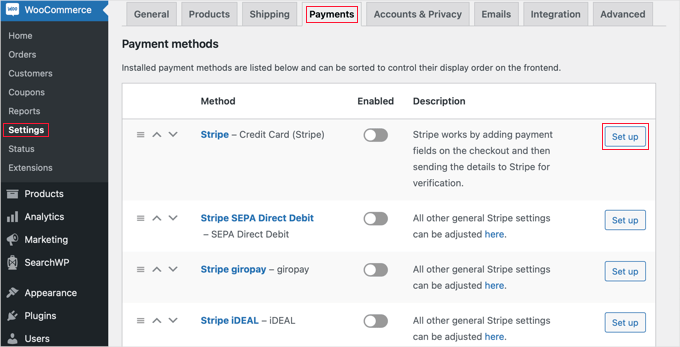
You need to start by clicking the ‘Set up’ button next to ‘Stripe – Credit Card’. This will launch a setup wizard that takes you through the steps of connecting WooCommerce to Stripe.
On the next screen, click on the ‘Enter account keys’ button.
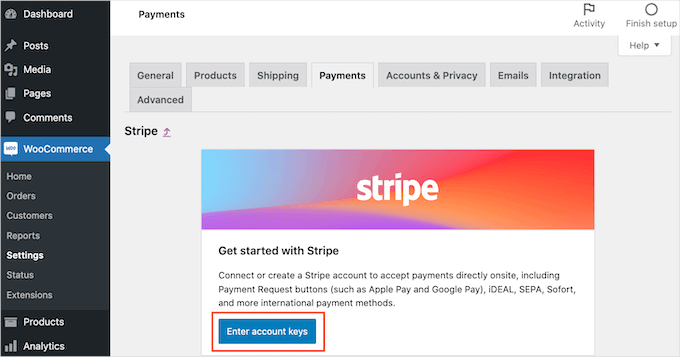
WooCommerce will now ask for your Stripe account keys. To get this information, you need to log into your Stripe dashboard in a new tab.
Inside the Stripe dashboard, you should make sure you’re on the ‘Developers’ tab at the top of the screen and then select ‘API keys’ from the left-hand menu.
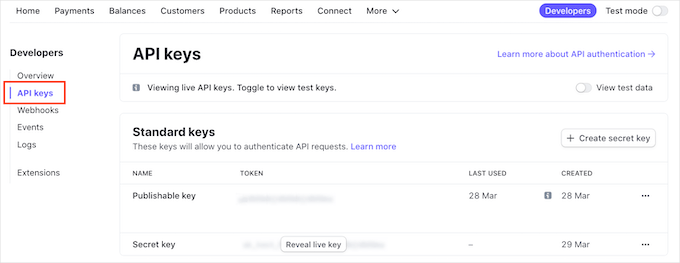
You can now copy the ‘Publishable key.’
Then, switch back to your WordPress dashboard and paste this key into the ‘Live publishable key’ field.
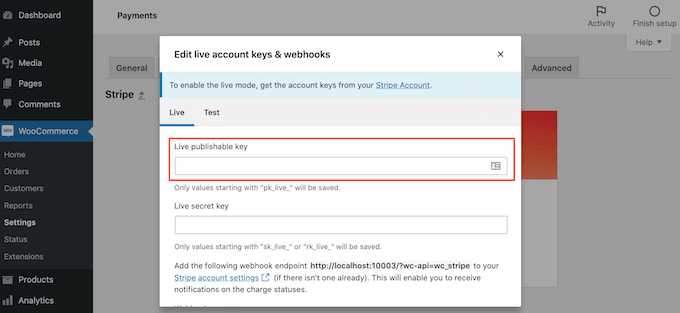
Now, you need to do the same thing with the secret key. Simply switch back to your Stripe dashboard and click on the ‘Reveal live key’ button.
This will show your secret key.
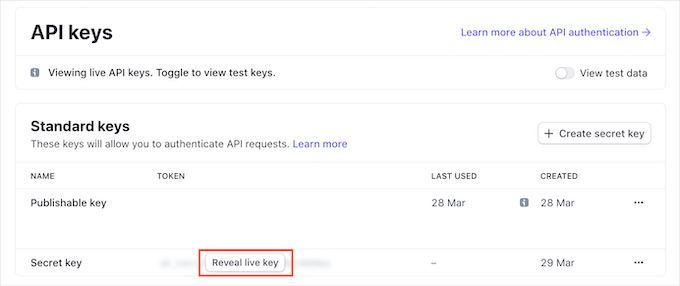
You need to copy the key and then head back to your WordPress dashboard and paste it into the ‘Live secret key’ field.
After that, just click on the ‘Test connection’ link.
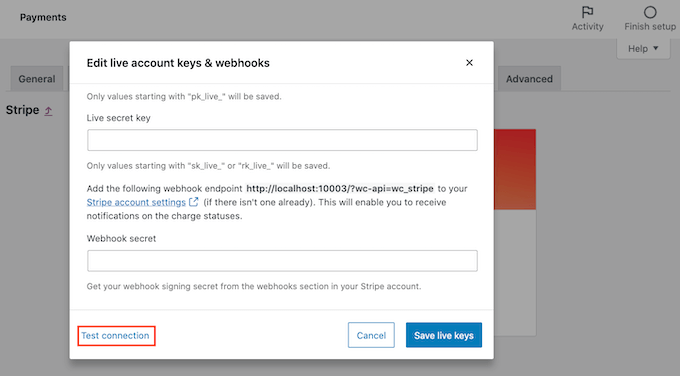
After a few moments, you will see a ‘Connection successful’ message. This means that WooCommerce is now connected to your Stripe account.
You can now go ahead and click on the ‘Save live keys’ button.
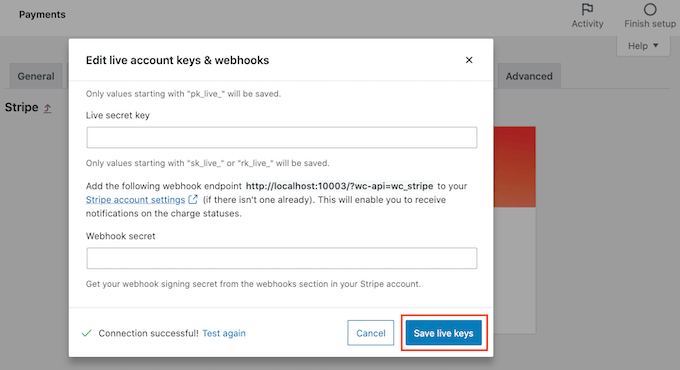
Then, you’ll be redirected to the Stripe ‘Settings’ screen.
On this screen, you’ll need to check the ‘Enable Stripe’ box. If you like, you can also click the ‘Enable test mode’ box.
Test mode lets you make payments that are not actually charged to an account. This is useful when testing multiple payment types in your WooCommerce store. Remember to uncheck the setting when you are ready to start taking payments.
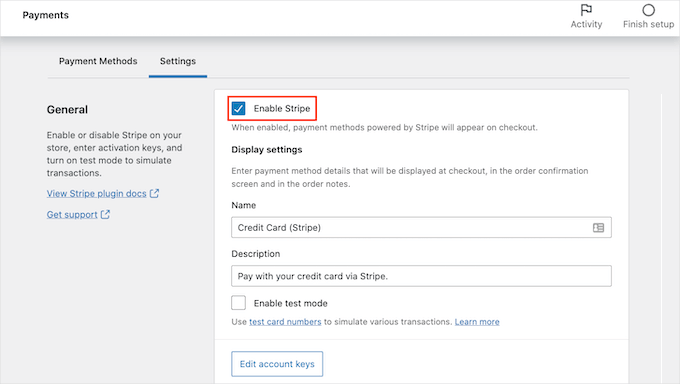
You can now scroll to the very bottom of the page and click the ‘Save Changes’ button to store your settings.
Now that you have enabled Stripe credit card payments, you can enable any additional Stripe payment methods you would like to offer on your online store.
Head back to WooCommerce » Settings and click the ‘Payments’ tab. Once there, you can explore the payment methods that work with your store’s currency.
For this tutorial, we’ll enable Alipay. You need to find ‘Stripe Alipay’ in the list of payment methods and then click its ‘Set up’ button.
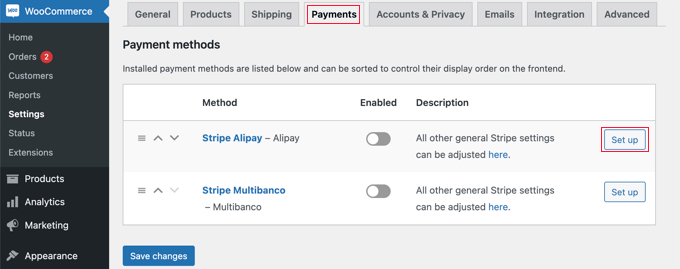
Here, you can click the ‘Enable Alipay’ button. This will display Alipay as a payment option when checking out.
Next, you can click the ‘Save changes’ button to store your settings.
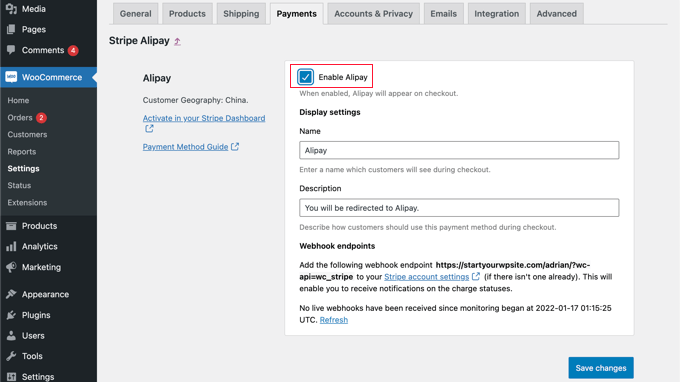
Alternative: Instead of using WooCommerce’s default Stripe addon, you can use the free Stripe Payment Gateway for WooCommerce plugin, created by FunnelKit.
It supports Stripe, Apple Pay, Google Pay, SEPA, iDEAL, and more. It also comes with extra features like an easy setup wizard, automatic webhook creation, one-click express payments, and more.
Adding Recurring Payments to WooCommerce
Another way to offer flexible payment arrangements to your WooCommerce customers is to add recurring payments, which will automatically charge them weekly, monthly, quarterly, or annually.
This automates the billing process to save you time. You won’t have to manually send invoices and recurring payments generally lead to fewer payment delays and errors.
To learn more, see Method 4 in our guide on how to accept recurring payments in WordPress.
Now, when your customers check out, they will be able to choose their preferred payment method. Here’s an example screenshot from our demo WooCommerce store.
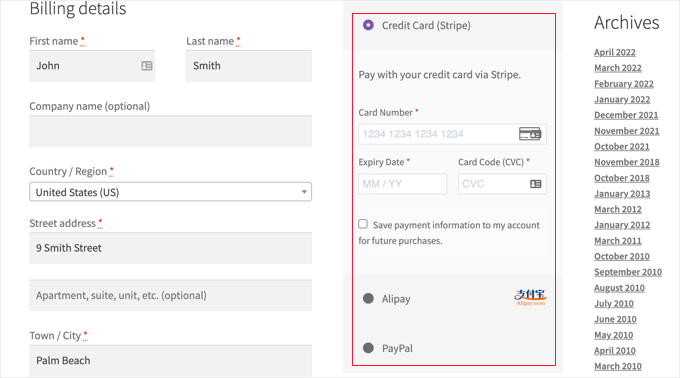
Our customers are able to make payments using credit cards, PayPal, and Alipay.
Method 3: Offering Multiple Payment Methods Using WPForms
WPForms is the best drag-and-drop form builder plugin for WordPress. It lets you create a simple order form or donation form without the hassle of a full-fledged eCommerce platform or shopping cart plugin.
On our website, we use WPForms for our contact form, site migration request form, and annual user survey. To learn more about the form builder, read our extensive WPForms review.
The first thing you need to do is install and activate the WPForms plugin. For more details, see our step-by-step guide on how to install a WordPress plugin.
You will need their Pro plan to access the Stripe, PayPal, Square, and Authorize.net payment addons. It also offers a library of 1800+ templates with multiple order form templates, recurring payments, and no additional transaction fees.
There is a free WPForms Lite version that allows you to accept one-time Stripe payments. But there’s an additional 3% transaction fee on payments made through your forms.
Upon activation, you need to visit the WPForms » Settings page to enter your license key. You can find this information in your WPForms account area.
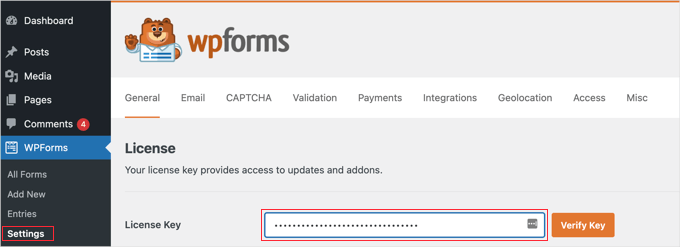
Connecting Payment Platforms to WPForms
Next, we’ll connect WPForms with the payment platforms you plan to use. To do this, you’ll need to head over to WPForms » Addons and install the payment addons.
Once there, scroll down to the PayPal Standard Addon and then click on its ‘Install Addon’ button.
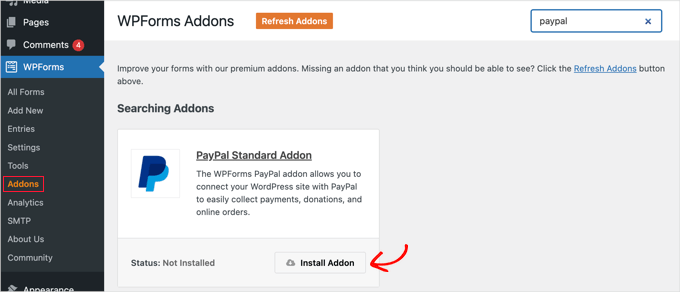
You’ll see a message saying that the addon has been installed and activated, and the text on the button will change to ‘Deactivate.’
We’ll set up your PayPal account details later in the tutorial.
You’ll also need to install an add-on to accept credit card payments. WPForms supports Stripe, Square, and Authorize.net. For this tutorial, we’ll set up Stripe, but the steps for setting up the other platforms are similar.
You’ll need to scroll to the Stripe Addon and click on the ‘Install Addon’ button.
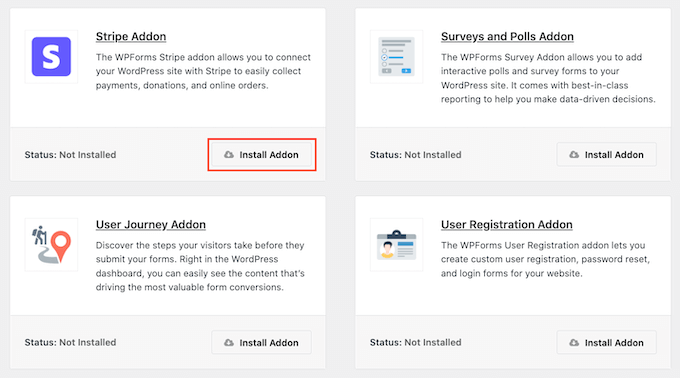
Once the addons have been installed and activated, you’ll need to connect WPForms to your Stripe account.
To do that, head over to WPForms » Settings page and click on the ‘Payments’ tab. After that, you will need to connect your Stripe account by clicking the ‘Connect with Stripe’ button.

On the next screen, enter your Stripe email address and click the ‘Next’ button. Once you have done this, Stripe will ask for your password to log in to your account.
After logging in, you can select your Stripe account and then click the ‘Connect’ button. You’ll then be redirected back to the WPForms Payments settings tab.
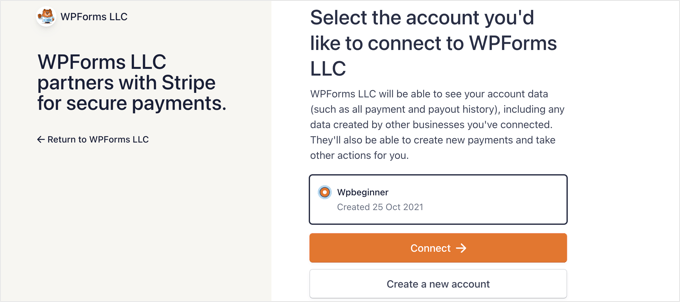
To make sure that your account is successfully connected, you can go to the ‘Connection Status’ settings under Stripe settings.
When you see a green tick mark, it means that your Stripe account is now live with WPForms. Go ahead and click the ‘Save Settings’ button to store your settings.
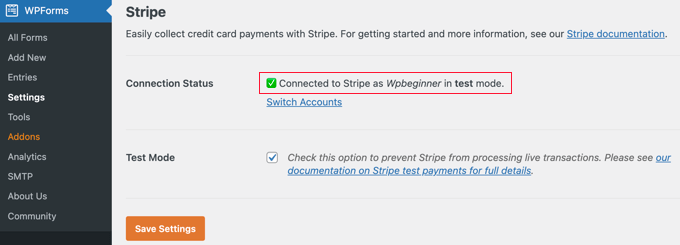
WPForms is now ready to accept credit card payments.
Creating an Order Form With Multiple Payment Methods
Now, we’ll create an online order form that can accept both PayPal and credit card payments.
To start, head over to the WPForms » Add New page. From here, you need to provide a title for your form and then select the ‘Billing / Order Form’ template.
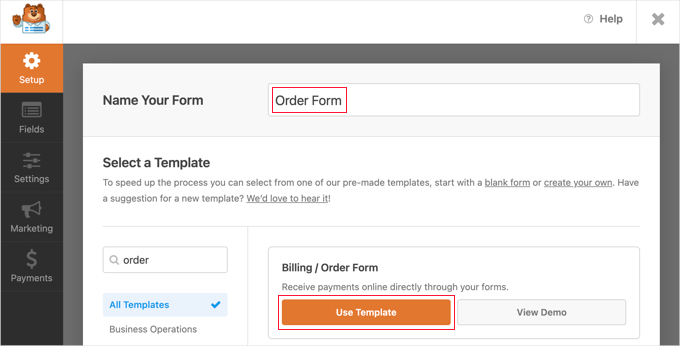
WPForms will pre-load the form builder with a simple order form with commonly used fields.
You can edit any field by clicking it. Need to reorganize the fields for a better flow? Simply drag and drop a field to move it around.
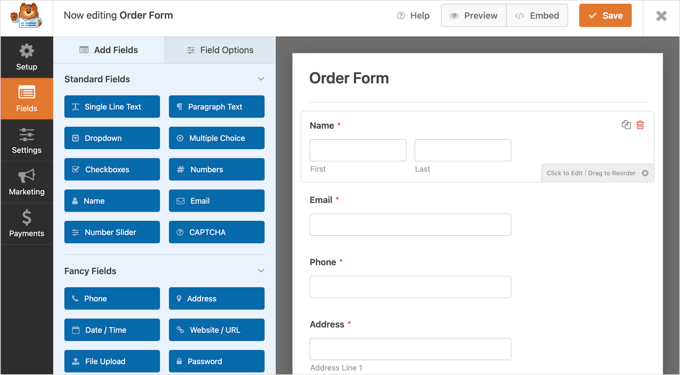
To add a new field, you can choose from the available fields to the left of the live preview.
Let’s try adding a multiple-choice field to your form to allow users to select their preferred payment options. You can simply click the field or drag it onto the form, whichever way you prefer.
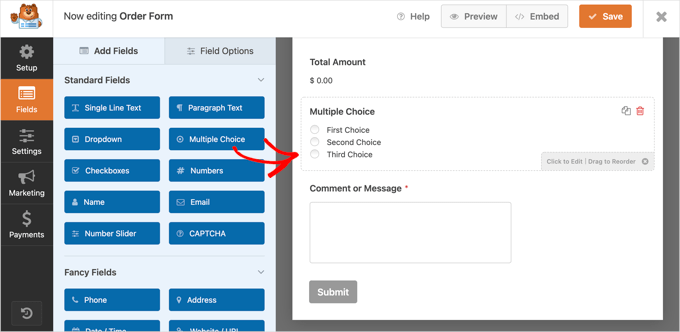
After that, you’ll want to drag the ‘Stripe Credit Card’ field onto the form.
You can place it just underneath the ‘Multiple Choice’ field.
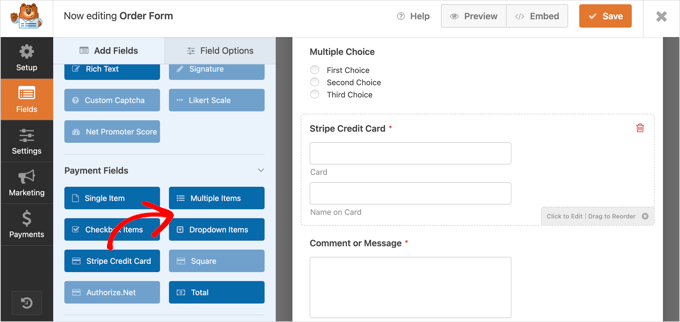
Next, you can click on the ‘Multiple Choice’ field and change the label and options to match the payment methods you offer.
Start by typing ‘Payment Method’ into the label field. After that, you should name the first two choices, ‘PayPal’ and ‘Credit Card’. Then, simply remove the third choice by clicking the red minus ‘-‘ button.
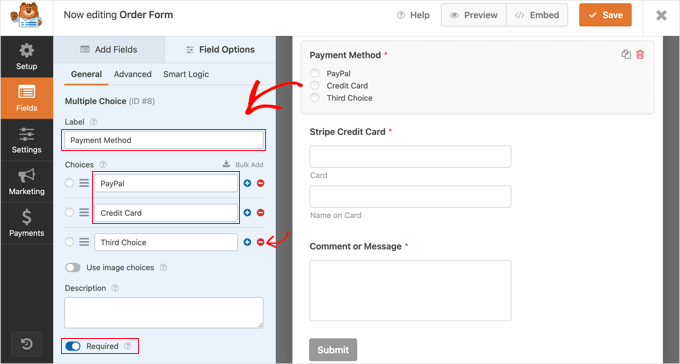
You’ll then want to switch the ‘Required’ option to ON. This will make sure that users select a payment method before they submit the order form.
Let’s move on to setting up the ‘Stripe Credit Card’ field. We want it to be hidden until a user selects it as their payment option, so we’ll need to use WPForms’ conditional logic feature.
To get started, you’ll need to click on the ‘Stripe’ field so that you can edit it. Then, you’ll want to open the ‘Smart Logic’ tab and enable conditional logic by clicking the toggle switch to the ON position.
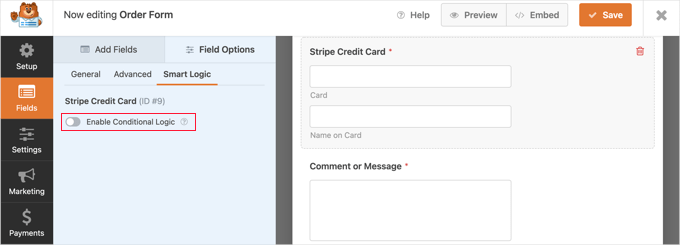
You will now see some additional options that allow you to set up rules for the field.
You need to make sure that the first option is selected to ‘Show’ and then use the drop-down menus so that the remaining fields say ‘Payment is Credit Card.’
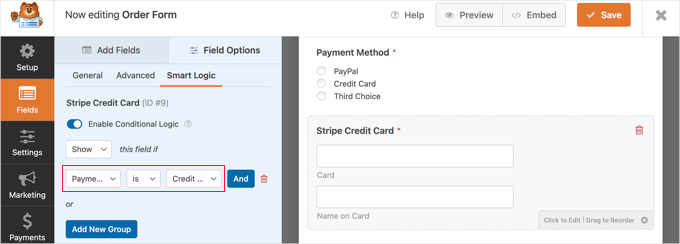
Once done, the ‘Stripe Credit Card’ field will only be shown after a user selects ‘Credit Card’ from the ‘Payment Method’ field.
Enabling Payment Methods on the Order Form
Next, we’ll enable PayPal and Stripe payments for the order form.
You should first navigate to Payments » PayPal Standard in the WPForms form builder. Then, you should check the ‘Enable PayPal Standard payments’ box in the right panel.
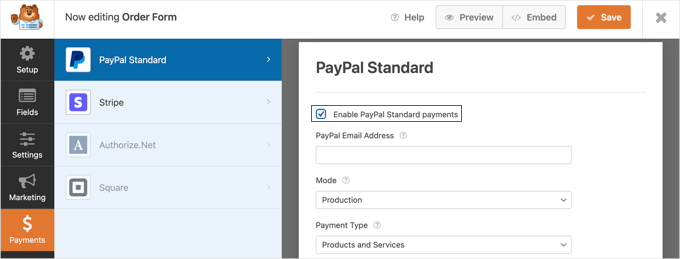
This will open the PayPal form details that you should fill out.
Simply type in your PayPal email address and place the account in ‘Production’ mode. You’ll also need to configure whether users need to supply a shipping address.
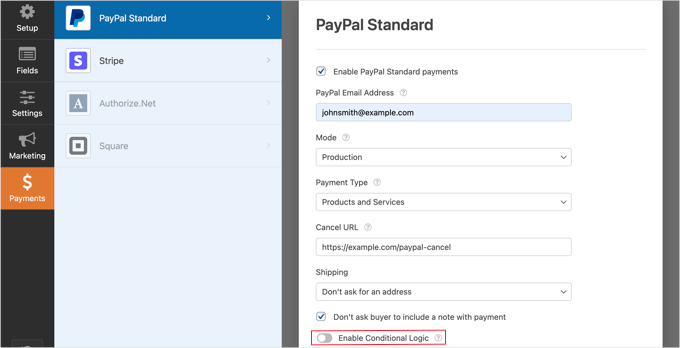
After that, you need to scroll down to the ‘Enable Conditional Logic’ option and toggle it to the ON position.
Once enabled, it will reveal more settings.

You should set the rule to ‘Process this charge if the Payment Method is PayPal.’
Next, you’ll need to click on the ‘Stripe’ section of the ‘Payments’ tab and then check the ‘Enable Stripe payments’ box.
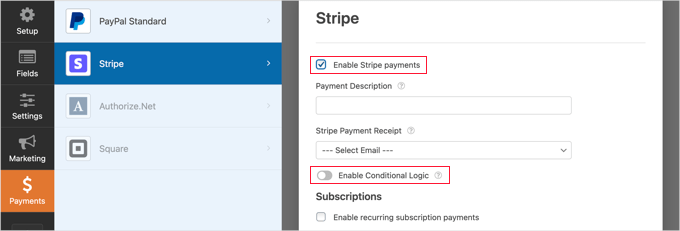
You can add a payment description and opt to email a receipt if you wish.
After that, you need to switch the ‘Enable Conditional Logic’ toggle to the ON position so that you can create a rule for this payment option.

You need to configure the rule so that it reads, ‘Process this charge if the Payment Method is Credit Card.’
If you’d like to accept recurring subscription payments by credit card, then you can scroll down to the Subscriptions section and configure it.
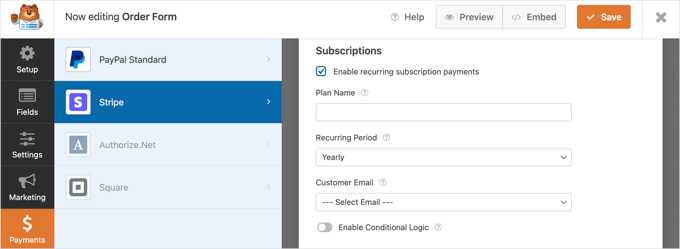
Once you are done, you need to click on the ‘Save’ button at the top and exit the form builder.
Adding the Order Form to Your WordPress Site
Your online order form with multiple payment options is now ready, and you can add it to any WordPress page on your site.
To add your form, simply edit a post or page or create a new one. Then, click on the plus ‘+’ sign on the right of the page and add a WPForms block in your WordPress editor.
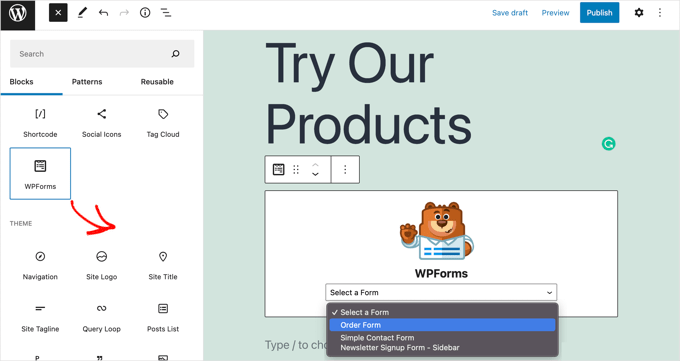
After that, you’ll need to click on the drop-down menu in the WPForms block and then select your order form. When you’ve finished, make sure you save or publish the page.
Now, you can see your form in action by clicking the ‘Preview’ button at the top of the screen.
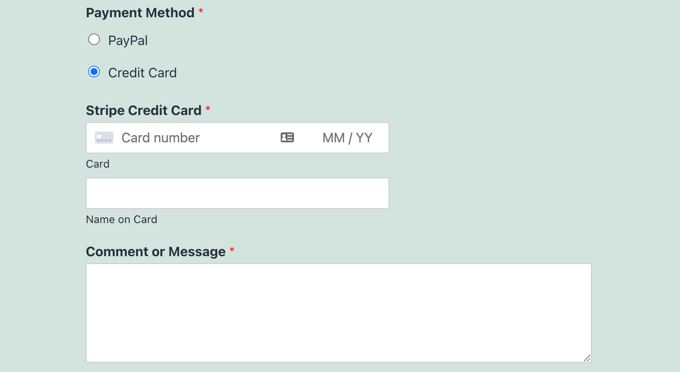
Bonus Tip: Offer the ‘Buy Now, Pay Later’ Payment Method
Offering a ‘Buy Now, Pay Later’ (BNPL) option is a smart way to make shopping easier for your customers. It’s perfect for those who want to spread out their payments into smaller, more manageable chunks.
Adding BNPL to your WordPress forms can further enhance the checkout experience, bring in more customers, and even help increase sales. Here’s why it’s worth considering:
- Stay Ahead of the Curve: BNPL is a growing trend in eCommerce, and offering it keeps your business competitive.
- More Flexibility for Shoppers: With BNPL, customers have more payment options, which can lower cart abandonment rates.
- Boost Your Sales: People are more likely to buy when they don’t have to pay everything upfront.
It’s a win-win for both you and your customers! Plus, it’s easy to do so using WP Simple Pay.
For a detailed guide, see our guide on adding ‘Buy Now Pay Later’ payment plans to WordPress.
We hope this tutorial has helped you learn how to allow users to choose a payment method on your WordPress form. Next, you may also want to see our expert picks of the best calculator plugins or our step-by-step guide on how to require terms of service agreement in WordPress.
If you liked this article, then please subscribe to our YouTube Channel for WordPress video tutorials. You can also find us on Twitter and Facebook.





Jiří Vaněk
It’s a great article on adding payment methods. Initially, I made a big mistake by focusing only on PayPal and was really surprised that I wasn’t getting many payments. Understanding that I needed to expand my payment options has helped me a lot in getting more business from my website. Thanks for the new insights and information on the different methods that can be used.
WPBeginner Support
Glad to hear our guide and recommendations were helpful!
Admin
kzain
This is a super informative post for adding payment methods to my WordPress forms!
The breakdown of using a payment gateway plugin like WPForms makes the process seem manageable. I particularly like the emphasis on user experience by offering multiple payment options.
Dennis Muthomi
a big thanks for this super detailed, step-by-step guide on setting up payment methods for WordPress! It’s really helpful.
Just one thing though – I was hoping to see some info on using cryptocurrencies like Bitcoin as a payment option. Is there a plugin out there that could make that happen? It’d be great to have that covered too. But overall, awesome job on this article! Cheers!
WPBeginner Support
For a starting point for cryptocurrencies, we would recommend taking a look at our article below!
https://www.wpbeginner.com/plugins/how-to-accept-bitcoin-payments-in-wordpress/
Admin
Dennis Muthomi
awesome!…thanks for sharing and taking the time to provide that helpful resource, I’ll definitely check it out
Phil
Many thanks for this tutorial, but how to set 2 choices (CB or check), i’ve try, but the form continue to ask cb informations when check is selection by the client…
WPBeginner Support
You would want to ensure you have smart logic enabled and if you continue to run into this issue, please reach out to WPForms and they should be able to assist.
Admin